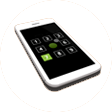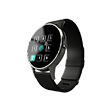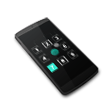When commuting to work, we select our favorite albums on our smartphones to sing along to. When traveling, we often type in the destination using a maps app. Throughout the day, we check our email, make phone calls, send texts, and so much more–all on our smartphones. We hold onto these handheld computers with white knuckles because it’s our way of communicating with the outside world. We live in a society where the smartphone parallels productivity and connectedness. While these fancy, rectangular devices are designed to meet the needs of the general public, they aren’t necessarily accessible for all individuals, especially the visually impaired or blind. This is where Project RAY steps in.
Let’s begin with some general smartphone questions:
- When was the last time you checked your smartphone? (This includes checking the time, email, text messages, social media, etc.)
- Can you guesstimate how many times a day you check your phone?
- What about how many times the average user checks his or her phone daily?
According to this article from 2014, average smartphone users spend 2 hours and 57 minutes on their phone each day. Another source hints at users checking their phones between 110-150 times daily, with the latter number being more probable. Crazy to think about, isn’t it? It’s been noted that countless individuals check their email, social media, and more, without even recognizing it! With this fact, it’s safe to say we often take smartphones for granted.
Smartphones give us access to the entire world, what ever would we do if we didn’t have one?
In previous posts, I have covered apps for the visually impaired, as well as accessible features on iOS 8. Though these may be beneficial to users who are blind or visually impaired, they aren’t designed to be entirely “eye-free” like Project RAY.
Over 4 years ago, individuals at Project RAY were on a mission to bring smartphone technology to the blind and visually impaired. Project RAY now has a line of high-tech smartphones and mobile apps specifically designed for individuals with visual impairments.
“We knew that adapting existing smartphones with special features wasn’t enough to provide real independence, advanced communication and services to the worldwide community of blind and visually impaired people. We also realized that the multiple devices and services the average visually impaired person needed to benefit from modern mobility technology was overwhelming in both budget and the sheer range of user interfaces each individual needed to learn.”
5 Project RAY Products for Visually Impaired
1. RAY G1
RAY G1 is “moderately priced” ($599) and gives users total eye-free access to features such as: voice calls, messaging, calendar, GPS, color identification, picture transcription and more!
RAY’s intuitive eye-free interface with touchscreen is easily done with  their patented “touch anywhere, slide your finger and lift” method. “The interface provides homogenous interfaces across all system functions, single gesture to frequently used functions, and one-hand operation.” Voice commands using speech recognition may be used for certain functions.
their patented “touch anywhere, slide your finger and lift” method. “The interface provides homogenous interfaces across all system functions, single gesture to frequently used functions, and one-hand operation.” Voice commands using speech recognition may be used for certain functions.
2. RAY M360
The sci-fi idea of being able to control your device (Android phone) remotely without even touching it becomes a reality with the world’s  first Android Based Smartwatch, the RAY M360.
first Android Based Smartwatch, the RAY M360.
The RAY M360 is available to preorder for $349.99. This smartwatch allows users to do just about anything with voice or touch, sending commands in real-time to their Android device. The smartwatch offers similar intuitive features to the RAY G1, such as the eye-free user interface, GPS, messaging, calendar, identification and more!
3. RAY N5
The RAY N5 is built on Google’s Nexus 5 Platform, providing users dual mode access to RAY or Android mode, complete with accessibility features such as eye-free user interface, vocal and haptic response for  all messages, voice dial and speech recognition functions.
all messages, voice dial and speech recognition functions.
According to Project RAY’s description on the N5, those features are just “the tip of the iceberg.” The RAY N5 goes even further by providing some of the most advanced “voice and touch operated features like emails, contact management, event scheduler, recording, navigation, NFC tag reading, device settings, audio books library and a lot more.” For $699, the N5 provides total eye-free access to complete tasks in a much more efficient way.
4. RAY App
The RAY App is free to download on the Google Play Store and is a revolutionary way to operate one’s Android device. “Replacing the traditional click interaction to directional swipes on the screen makes usability of this app easy to understand and stress-free.” On this free app, you’ll also be able to change the appearance of the screen to high-contrast.
traditional click interaction to directional swipes on the screen makes usability of this app easy to understand and stress-free.” On this free app, you’ll also be able to change the appearance of the screen to high-contrast.
By downloading this free app, users have access to features such as:
- One hand operation
- Text-to-speech
- Voice-operated speed dial
- Messaging services
- Contact list
- Clock
- Voice SMS
- Calendar
- And more!
5. RayGo
RayGo is the company’s newest invention: a device that gives users total eye-free AND hand-free control over their smartphones. RayGo is ![]() a revolutionary device that allows the visually impaired to fully control their RAY smartphone while holding the “guide-cane or dog’s leash, keeping the other hand free.”
a revolutionary device that allows the visually impaired to fully control their RAY smartphone while holding the “guide-cane or dog’s leash, keeping the other hand free.”
To use the device, Project RAY says to “attach it to the top of your cane or guide dog’s leash and use your thumb to control the smartphone with up and down arrow keys [found on RayGo].”
The RayGo is available to preorder now for $49.
To learn more on Project RAY, visit their website.
